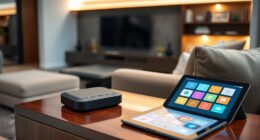To protect your vision while using screens, limit your exposure by taking regular breaks and following the 20-20-20 rule—look at something 20 feet away for 20 seconds every 20 minutes. Use blue light filters or glasses, keep proper ambient lighting, and stay hydrated. Remember to blink often to prevent dryness and avoid harsh glare. Want to discover more simple ways to keep your eyes comfortable? Keep exploring to learn additional tips.
Key Takeaways
- Use blue light filters or night mode settings on devices to reduce eye strain.
- Follow the 20-20-20 rule: look at something 20 feet away for 20 seconds every 20 minutes.
- Wear blue light blocking glasses during prolonged screen use to protect eyes from deep blue light penetration.
- Maintain proper ambient lighting and minimize glare to prevent additional eye discomfort.
- Take regular breaks and consciously blink more often to prevent dryness and relax eye muscles.

As screens become an increasingly common part of daily life, many people find themselves experiencing eyestrain more often. The constant exposure to digital devices can lead to discomfort, fatigue, and even headaches. One of the main culprits is blue light, which is emitted in large amounts from screens like smartphones, tablets, and computers. Blue light penetrates deep into your eyes and can cause digital eye strain, making your eyes feel tired and dry after prolonged use. To protect your vision, it’s essential to be mindful of how blue light affects your eyes and to take steps to reduce its impact.
Blue light from screens can cause eyestrain, fatigue, and dryness after prolonged use.
Another factor that contributes to eyestrain is blinking frequency. When you’re focused intently on a screen, your blinking rate naturally decreases, often dropping from about 15-20 blinks per minute to as low as 5-7. This reduced blinking causes your eyes to become dry and irritated because blinking is your body’s way of spreading tears evenly over the eye surface to keep them moist. The combination of blue light exposure and decreased blinking can amplify discomfort, leading to a cycle of eye fatigue that’s hard to break without intentional effort.
To combat these issues, you can start by adjusting your screen settings. Many devices now have built-in blue light filters or “night mode” options, which reduce blue light emissions and make screens easier on your eyes, especially in low-light conditions. Wearing glasses with blue light blocking lenses can also help, especially if you spend hours in front of screens daily. These lenses filter out a significant portion of blue light, reducing eye strain and protecting your retina over time.
In addition, make a conscious effort to increase your blinking frequency. Every 20 minutes, take a break and consciously blink several times to refresh your eyes. This simple action can prevent dryness and discomfort. Following the 20-20-20 rule—every 20 minutes, look at something 20 feet away for at least 20 seconds—helps relax your eye muscles and reduces strain. Maintaining proper lighting in your environment is equally important; avoid glare on screens and ensure ambient light isn’t too harsh or dim.
Staying hydrated and using artificial tears can also alleviate dryness caused by reduced blinking. Remember, your eyes need moisture and rest just like any other part of your body. By being mindful of blue light exposure, blinking more often, and taking regular breaks, you can considerably reduce eyestrain and preserve your vision in this digital age. Protecting your eyes isn’t just about comfort; it’s about maintaining good eye health for the future.
Frequently Asked Questions
Can Eyestrain Lead to Long-Term Vision Loss?
Eyestrain itself doesn’t cause long-term vision loss, but ignoring your eye health can lead to issues. Poor contact lens safety and sleep disturbance can worsen eye problems over time. If you don’t take care of your eyes, you risk developing more serious conditions like dry eyes or infections. To protect your vision, follow proper contact lens hygiene, get enough sleep, and take regular breaks from screens.
Are There Specific Exercises to Prevent Eyestrain?
While exercises alone can’t completely prevent eyestrain, they can substantially help. You should practice eye relaxation techniques by focusing on distant objects to reduce strain. Incorporate blinking techniques—blink slowly and deliberately—to keep your eyes moist and refreshed. These simple exercises break up prolonged screen time, easing eye fatigue and maintaining your visual comfort. Regularly doing so can help protect your vision amid constant digital exposure.
How Does Blue Light Affect Eye Health?
Blue light from screens impacts your eye health by potentially causing digital eye strain and disrupting sleep patterns. Blue light technology, used in many devices, emits high-energy wavelengths that can harm your eyes over time. Eye health research suggests limiting exposure, especially before bed, and using blue light filters or glasses. Taking breaks and adjusting screen settings helps protect your vision and reduces long-term damage.
Do Glasses With Blue Light Filters Help?
You might wonder if glasses with blue light filters help. These glasses can block some blue light benefits, reducing glare and enhancing comfort. Anti-reflective coatings further improve vision by minimizing reflections and eye strain. While they don’t eliminate all digital eye issues, wearing such glasses can make screen time more comfortable and protect your eyes from potential strain caused by prolonged exposure to blue light.
What Are the Symptoms of Digital Eye Strain?
Digital eye strain can cause symptoms like dry, itchy eyes, blurred vision, and headaches. You might also feel eye discomfort or experience digital eye fatigue after long screen sessions. To improve screen comfort, take regular breaks, follow the 20-20-20 rule, and guarantee proper lighting. These habits help reduce eye strain, keep your eyes comfortable, and prevent long-term vision issues.
Conclusion
To protect your vision in this digital world, think of your eyes as delicate flowers that need tending. Limit screen time, take frequent breaks, and blink often—like watering and nourishing your blooms. Adjust your lighting and keep screens at eye level, so your eyes don’t strain under unnecessary weight. By caring for your eyes with gentle attention, you’ll keep your vision clear and vibrant, letting your world shine as brightly as your gaze.
Alfons is the visionary leader and driving force behind Voyager Info’s success. As the Editor in Chief, he brings a wealth of experience and an unwavering passion for travel to the helm of our cruise-centric platform.
With a lifelong fascination for exploring new horizons, Alfons discovered his love for the ocean and cruising at a young age. From sailing across pristine Caribbean waters to embarking on daring expeditions to far-flung destinations, he has amassed a treasure trove of first-hand experiences in the world of cruising.











